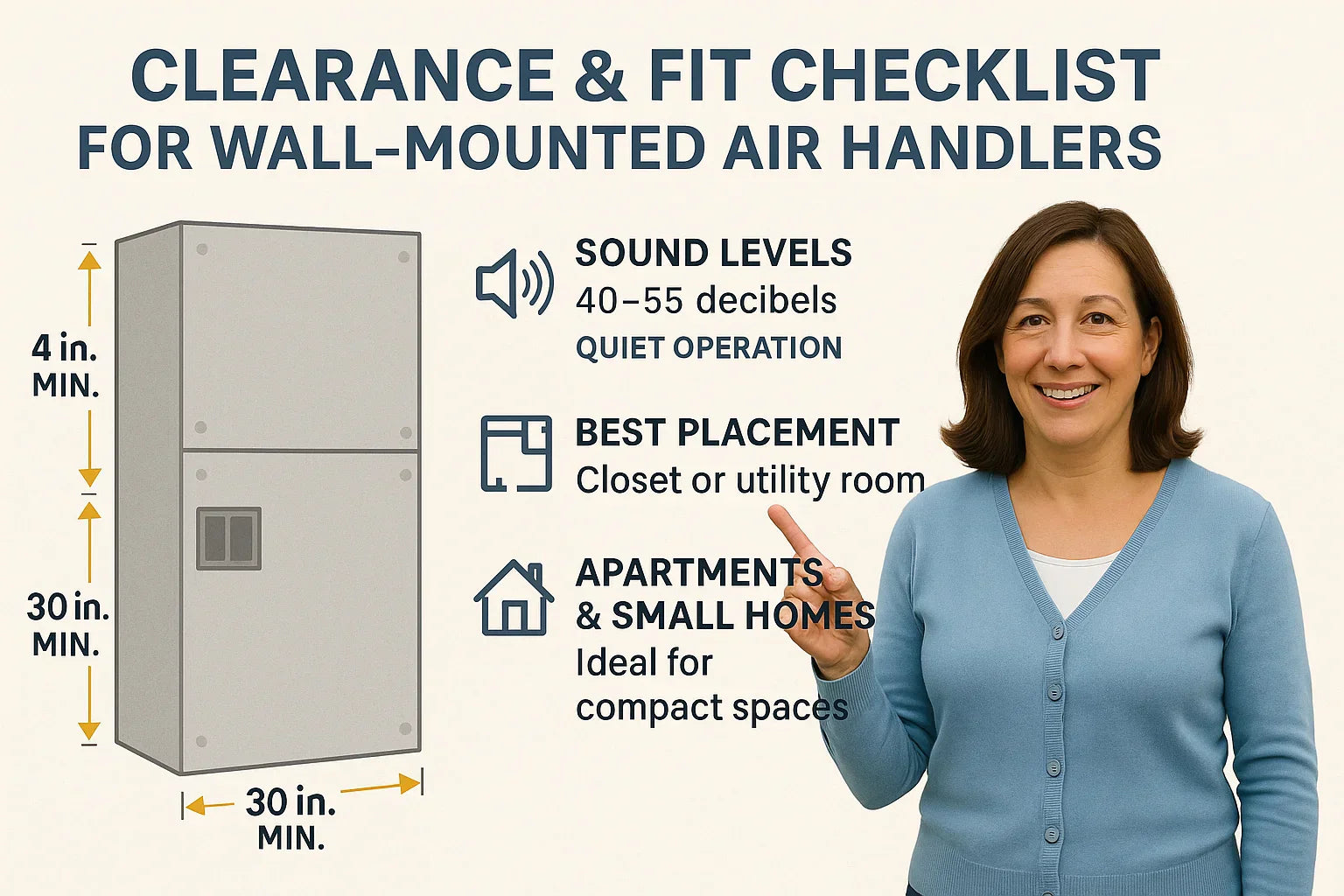When I started shopping for my new HVAC system, I had a list of must-haves: efficiency, comfort, and something that wouldn’t take up too much space. That’s how I landed on the Goodman 2 Ton R-32 Compatible Wall-Mounted Air Handler with Built-In TXV and 5 kW Heater.
But here’s the thing—before buying, I had to ask myself:
👉 “Will a wall-mounted air handler really fit my home setup?”
It wasn’t just about the physical dimensions. I wanted to know about noise, clearance requirements, and how it would look inside my home.
In this guide, I’ll share what I learned about fitting a wall-mounted Goodman air handler into different homes, plus my personal experience installing one in my own hall closet.
🔊 Noise Levels Explained
No one wants an HVAC system that sounds like a jet engine. Noise was one of my biggest concerns.
Typical Noise Levels
-
Goodman’s wall-mounted units operate around 40–55 decibels (dB) depending on fan speed.
-
For comparison:
-
Whisper: 30 dB
-
Normal conversation: 60 dB
-
Window AC: 70 dB+
-
👉 That means a Goodman wall-mounted air handler is quieter than most window AC units, and about the same as the hum of a refrigerator.
Tips for Noise Reduction
-
Placement matters: Keep it away from bedrooms if you’re sensitive to sound.
-
Duct sealing: Leaky ducts amplify airflow noise.
-
Anti-vibration pads: Help reduce low-frequency hum.
👉 The Air Conditioning Contractors of America (ACCA) recommends ensuring proper airflow sizing to avoid “whistling” vents that make systems seem louder.
📏 Space Requirements & Clearance
One of the biggest advantages of wall-mounted air handlers is how compact they are.
Goodman AWST24SU1305 Dimensions
-
Width: 20.2 inches
-
Height: ~50 inches
-
Depth: ~22 inches
This makes it easy to fit into hall closets, utility rooms, or even apartment alcoves.
Clearance Guidelines
According to Goodman’s specs and the U.S. Department of Energy:
-
Front clearance: 24–30 inches for service access
-
Sides/top clearance: 2–4 inches minimum
-
Bottom clearance: Enough space for drain and airflow
Best Locations
-
✅ Hall closet (my choice—out of sight but accessible)
-
✅ Utility room (easy service access)
-
✅ Apartment corner (saves valuable floor space)
-
❌ Not recommended: tight attics or crawl spaces
🏠 Design Considerations
I’ll admit it—design mattered to me. I didn’t want an ugly metal box dominating my hallway.
How Wall-Mounted Units Blend In
-
Compact cabinet fits neatly in closets.
-
Works behind louvered doors for airflow.
-
Can be hidden with cabinetry or false walls.
Samantha’s Experience
I chose a hall closet install. We added a louvered bi-fold door for airflow, and now it looks like any other closet—guests don’t even notice it’s there.
👉 Energy Star notes that indoor placement choices affect both aesthetics and efficiency.
🌡️ Airflow & Comfort Impact
Placement isn’t just about looks—it affects how well your system cools and heats your home.
Things I Learned:
-
The air handler should be centrally located if possible for balanced airflow.
-
Duct runs should be kept short to minimize energy loss.
-
Return air needs to be unobstructed—don’t cram coats or boxes against the return grille.
⚖️ Pros vs. Cons of Wall-Mounted Air Handlers
Here’s the honest breakdown from my research and experience:
✅ Pros
-
Compact footprint (20.2” wide cabinet)
-
Easy service access compared to attic installs
-
Quieter than window AC or portable units
-
Factory-installed TXV and heater = better efficiency
❌ Cons
-
Not ideal for very large homes (over ~1,600 sq. ft.)
-
Requires 24–30” clearance in front (can limit closet storage)
-
Still produces a low hum—bedroom installs may bother light sleepers
👉 HVAC.com highlights wall-mounted units as a great fit for apartments, small homes, and add-ons, but less suited to sprawling layouts.
👩🏫 Samantha’s Real-World Take
When my Goodman was first installed, I held my breath—would it be too loud, too bulky, or awkward in my hall closet?
Here’s what I found after living with it:
-
Noise: It’s quieter than I expected. I hear a soft hum, but it’s not disruptive.
-
Space: The closet installation works perfectly—I still use the top shelf for storage.
-
Design: With the louvered door, you’d never know an air handler was inside.
👉 My conclusion: For a 1,200 sq. ft. home, the wall-mounted Goodman is a perfect fit.
✅ Final Takeaway
So, will a wall-mounted air handler fit your home setup?
-
🔊 Noise: Quiet enough for living spaces, though not silent.
-
📏 Space: Needs 20” width + 30” front clearance, perfect for closets/utility rooms.
-
🏠 Design: Easy to hide behind doors or cabinetry.
-
🌡️ Airflow: Central placement = best comfort.
👉 My advice: If your home is under ~1,400 sq. ft. and you’re short on utility space, a Goodman wall-mounted unit is a smart, efficient, and surprisingly low-profile choice.
In the next topic we will know more about: Goodman vs. Carrier vs. Lennox: Which 2 Ton R-32 Air Handler Is Best for Your Home?







